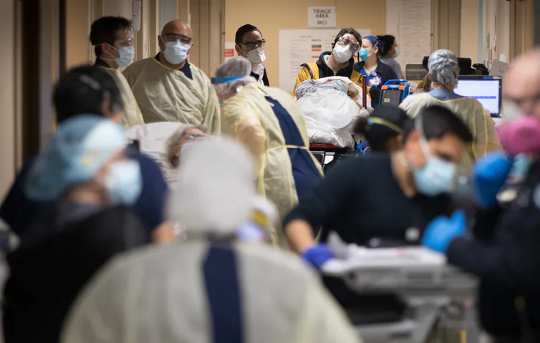 The arrival of flu season will put more pressure on hospitals already facing the coronavirus pandemic. Jeffrey Basinger/Newsday via Getty Images
The arrival of flu season will put more pressure on hospitals already facing the coronavirus pandemic. Jeffrey Basinger/Newsday via Getty Images
Flu season is just around the corner, and the United States still hasn’t contained the coronavirus. That sets up an unsettling challenge this fall: how to minimize the impact of the simultaneous spread of COVID-19 and seasonal influenza so hospitals aren’t overwhelmed.
As pandemic policy experts, we understand the strain that the combination of COVID-19 and influenza could have on our health care system. Our new report, COVID-19 and Seasonal Influenza: Preparing for a Collision, just published by the Scowcroft Institute of International Affairs at Texas A&M University, explains the risks and offers 10 recommendations.
The numbers suggest a risky fall and winter
Close to 5 million people in the United States have been infected with SARS-CoV-2, and more than 170,000 have died. In some hospitals, such as Starr County Memorial on the Texas-Mexico border, the caseloads overwhelmed capacity.
Given that both COVID-19 and influenza are respiratory viruses requiring similar supplies and equipment, hospitals that are already struggling to accommodate COVID-19 patients may not be able to manage the additional flu patients.
In recent years, influenza-related hospitalizations ranged from a low of around 280,000 in 2015-2016 to a high of 810,000 in 2017-2018. According to data from the American Hospital Association, as of March 2020 the U.S. had 924,107 total staffed hospital beds. If a city or state becomes both an influenza hot spot and a COVID-19 hot spot simultaneously, that would almost certainly overwhelm hospital capacity.
Additionally, some of the measures that have been effective in managing hospital surge capacity, such as Houston’s use of Texas Children’s Hospital for adult COVID-19 patients, might not be possible since children under 5 years of age are one of the groups most likely to have severe outcomes from seasonal influenza, including hospitalizations and deaths.
How to reduce the risk of a double whammy
To reduce the risk of a bad season of both COVID-19 and influenza overwhelming U.S. hospital capacity, our report offers 10 recommendations.
1) Increase the number of people who get the flu vaccine. The flu vaccine is one of our best defenses against seasonal flu, yet under 50% of adults and just over 60% of children get the annual vaccination. Increasing flu vaccine use could help keep thousands of children and adults out of the hospital.
2) Mandate face coverings at the state and local levels in accordance with CDC guidelines. Wearing masks, even when an individual feels healthy, can help reduce the spread of both the flu and COVID-19, particularly from pre-symptomatic or asymptomatic people. State and local officials should implement and enforce these mandates in accordance with CDC guidance and transmission risk in their communities.
3) Add sanitation measures and room ventilation in K-12 schools. With students returning to in-person classes in some districts, there is risk of increased COVID-19 spread, and schools are a well-known driver of seasonal influenza spread. Increasing room ventilation, holding classes and lunches outside whenever possible and making hand sanitizer readily available can reduce transmission risks.
4) Evaluate athletes’ cardiovascular condition before they return to practice after a COVID-19 infection to help prevent cardiac injury or post-infection complications. As college and professional fall sports return, it will be important to protect both the health of the fans and the safety of the athletes.
5) Maintain social distancing measures and quarantine procedures for travelers – doing so can minimize both the flu and COVID-19. As some countries lift travel restrictions, syndromic surveillance (i.e., monitoring people for symptoms such as fever) of airline passengers and other international travelers is important to reduce the risk of of spreading the virus.
6) Develop a vaccine infrastructure for producing and distributing a future COVID-19 vaccine. Vaccine development is not the only challenge in making a vaccine available to the world. It will also have to be produced and disseminated to billions of people – something never done before. That will require building or retrofitting factories and preparing transportation and distribution networks for the scale of the challenge.
7) Launch a vaccine education campaign to counter misinformation about both the influenza and COVID-19 vaccines. Vocal opposition to vaccines could hurt the United States’ ability to achieve herd immunity through a vaccine. We recommend developing a national campaign that can be implemented at the local level and led by local public health officials, business people, doctors and religious leaders.
8) Expand hospital capacity and production of medical equipment. Seasonal influenza alone can bring hospitals to near capacity. To accommodate two respiratory viruses simultaneously, we must find innovative ways to increase capacity and production of medical supplies and equipment. The ventilator shortages last spring were a warning.
9) Create a national strategy for COVID-19 response. The United States needs a national strategy to assist states with coordination, supply procurement, collaboration and guidance as they respond to the COVID-19 pandemic.
10) Establish greater COVID-19 data transparency at the local, state and federal levels. Information on COVID-19 can be confusing, with the differing symptoms and levels of severity and the initial confusion about what qualifies as a COVID-19 death. Additionally, there have been articles suggesting that data might not be accurately reported. With greater transparency and communication about how cases are recorded and why contract tracing is important, it may be possible to give the public a better understanding of the pandemic and reduce national anxiety.
The U.S. will almost certainly face a challenge this fall as students return to campuses and classrooms and people begin to travel more. Overwhelming hospitals is not inevitable, however, if the U.S. begins preparing now to manage both COVID-19 and influenza in its communities.![]()
About The Authors
Christine Crudo Blackburn, Deputy Director, Pandemic & Biosecurity Policy Program, Scowcroft Institute of International Affairs, Bush School of Government and Public Service, Texas A&M University; Andrew Natsios, Director, Scowcroft Institute of International Affairs and Executive Professor, Texas A&M University, and Leslie Ruyle, Associate Research Scientist and Assistant Director Scowcroft Institute of International Affairs, Bush School of Government and Public Service, Texas A&M University
This article is republished from The Conversation under a Creative Commons license. Read the original article.
Related Books:
The Body Keeps the Score: Brain Mind and Body in the Healing of Trauma
by Bessel van der Kolk
This book explores the connections between trauma and physical and mental health, offering insights and strategies for healing and recovery.
Click for more info or to order
Breath: The New Science of a Lost Art
by James Nestor
This book explores the science and practice of breathing, offering insights and techniques for improving physical and mental health.
Click for more info or to order
The Plant Paradox: The Hidden Dangers in "Healthy" Foods That Cause Disease and Weight Gain
by Steven R. Gundry
This book explores the links between diet, health, and disease, offering insights and strategies for improving overall health and wellness.
Click for more info or to order
The Immunity Code: The New Paradigm for Real Health and Radical Anti-Aging
by Joel Greene
This book offers a new perspective on health and immunity, drawing on principles of epigenetics and offering insights and strategies for optimizing health and aging.
Click for more info or to order
The Complete Guide to Fasting: Heal Your Body Through Intermittent, Alternate-Day, and Extended Fasting
by Dr. Jason Fung and Jimmy Moore
This book explores the science and practice of fasting offering insights and strategies for improving overall health and wellness.























